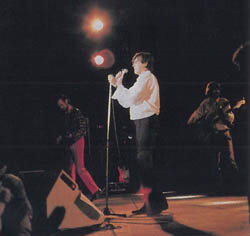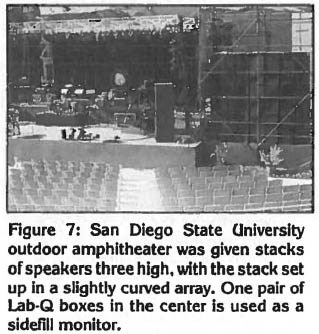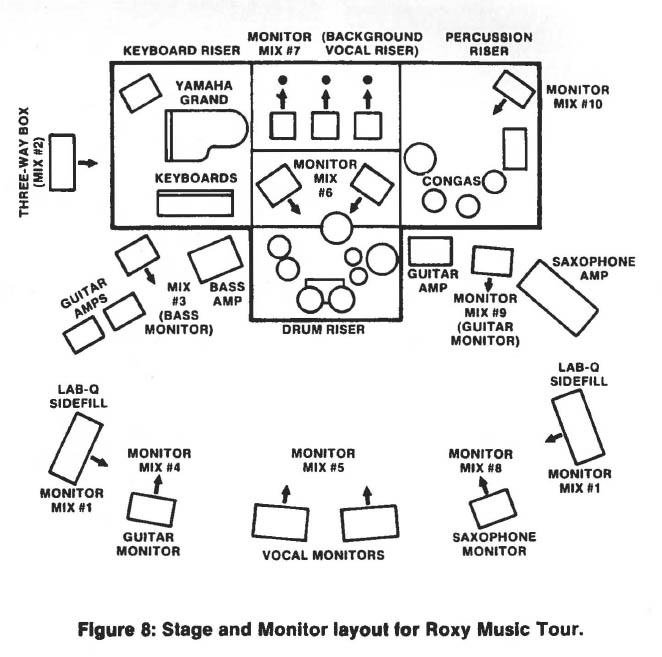
System Set-Up
The concert that this writer observed was staged at San Diego State University’s outdoor amphitheater, an open-air stage below ground level with high-rise concrete seating that describes an area of nearly 140 degrees.
To adequately cover such a venue, the main speaker stacks must be laid out to provide unusually wide coverage.
Electrotec sound system engineer Mike Gibney chose to set up the system in two stacks of 21 boxes each. The stacks were given a slight hemispherical curve out to the sides, and in towards the center of house (Figure 7). Low-end cabinets were arranged in columns of three, and mid/high cabinets put up in similar fashion.
The center of each stack comprised two columns of three low·end boxes apiece—quite a concentration of low-frequency energy in one spot. Since the distance between stacks was in excess of 60 feet, the monitor sidefill stacks were called upon to do double duty as center-house fill. Sidefills were placed slightly upstage of the front mike line, and angled across the downstage performing area, with their coverage pattern
hitting the center house seating sections.
The San Diego concert was only the second show of the Roxy Music tour. Since the system was fresh out on the road from rehearsals, much time was spent during the afternoon before sound check carrying out basic road preparation: cables were labeled, case packing charts prepared, and loose hardware tightened.
According to Gibney, basic system maintenance never ends when a system is on tour. “Every day there are things to watch for, gear to check on,” he says. “For instance, right now I am tracking down a hum in the house system, which is not normally present with this gear. There seems to be a ground loop occurring at the interface between the house and monitor consoles (splitter box), and it is a trial-and-error process to isolate and correct the problem.”
As Gibney got the main stacks in the air and hunted down the few inevitable bugs, Electrotec engineer Chris Amison tuned the system for the band’s engineer, and then proceeded to start the stage input hookup.
Stage Miking
Roxy Music features vocalist Bryan Ferry and saxophonist Andy Mackay, both of whom worked the downstage area. Ferry’s vocal mike was a Shure SM-78, while the sax was picked up with two inputs: an AKG D224E was fed into a small Yamaha self-contained 6-channel mixer, sweetened with a Roland Space Echo, and fed through Yamaha speaker cabinets, one of which was miked. Additionally, a wireless unit was taken as a direct input for a clean, unprocessed signal.
Electric guitar amps were miked with Shure SM-57s, while the bass guitar was taken as a direct input, as were the keyboards. A Yamaha 12-channel mixer received signal input from Guy Fletcher’s two Roland Jupiter synthesizers, Solina string synthesizer, Korg organ, Yamaha CP-80 electric piano, and Wurlitzer electric piano.
The resultant mix was processed through a Roland SDE-2000 delay unit, and then sent to the house and monitor consoles. Additionally, a direct input was taken on each individual keyboard instrument to ensure clean signals at the desks.
Roxy Music’s stage set this time out contained a generous amount of percussion, as can be seen in Figure 8. Andy Newmark’s large drum set, complete with gong, was picked up with two overhead AKG C414EB condenser mikes. Toms were miked individually with Sennheiser MD421s. and the kick received an Electro-Voice RE-20. The snare was miked from the top with a Shure SM-57, and hi-hat cymbals given an AKG C451 E. The auxiliary percussionists’ congas, roto-tom, chimes, and bells were picked up with a pair of Beyer M160 mikes.
A three-way splitter with individual ground-lift switching on each input line passed the signal to the house and monitor consoles, leaving one split available for broadcast pick up or recording. Model 8226 AMP brand connectors on 11-pair multicable carried the microphone signals to the splitter box from satellite plug·in boxes distributed around the performing area. These boxes were designed with an extra female connector on the end, so that boxes could be “daisy-chained” for additional length when needed.


